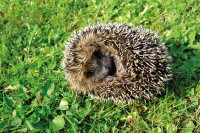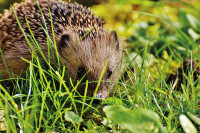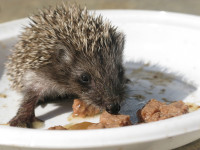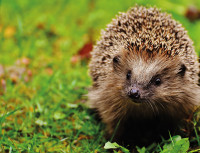Hedgehogs - A prickly situation!

Once classified as insectivorous, they are now considered omnivorous. Given that their diet has always included frogs, toads, snakes, snails, slugs and carrion, as well as insects and fruit, it is perhaps hard to fathom the original classification.
The UK resident is the European hedgehog (Erinaceus europaeus), one of seventeen species in five groups found across the world, apart from Australia, the Americas and colder climes. They were introduced into New Zealand where they are thriving.
Their name comes from their preferred habitat of hedgerows coupled with their pig-like snout. Their closest relatives are shrews.
They were once common, but are now under threat from development and habitat loss caused by the reduction of hedgerows, modern gardening methods and intensification of our agricultural and horticultural practices. In just the last ten years, hedgehog numbers have fallen by one-third, and there are now thought to be fewer than one million left in the UK.
The fall has led to an alert from The People's Trust For Endangered Species (PTES) and the British Hedgehog Preservation Society (BHPS), which hope householders and builders will help save the creature, immortalised by Beatrix Potter's Mrs Tiggy-Winkle.
As well as calling for less gravel, they have produced leaflets urging homeowners to make access holes in fences so that hedgehogs can travel to find food.

Despite the decline in numbers, hedgehogs currently only have a degree of protection from the law. They are listed on schedule 6 of the Wildlife and Countryside Act 1981, making it illegal to capture or kill them using certain methods. They are also protected from cruelty through the Wild Mammals Protection Act 1996.
Crucially, none of this legislation is actually relevant to any of the key reasons for why hedgehogs are declining, and thus it has limited relevance for the conservation of wild hedgehog populations.
A campaign has been launched to increase the protection offered to hedgehogs by putting them onto schedule 5 of the Wildlife and Countryside Act. Will this help? In a word, yes. By including hedgehogs on schedule 5, it would potentially mean that all developers have a requirement to survey for hedgehogs. If hedgehogs are found on a plot destined for development, appropriate mitigation would be required by law. This would be a great step forward.

Will it save the British hedgehog? Probably not. A complex range of interacting threats face hedgehogs, and using existing legislation alone is unlikely to be a magic solution. It could well be part of the solution however, alongside a better understanding of rural threats informing better rural land management, a smarter approach in infrastructure design, more action in existing gardens, and better amenity and greenspace management.
Hedgehogs are easy to identify, as they are the only spiny British mammals. A fully-grown adult may have as many as 5,000 spines. They have small ears, quite long legs, and a short tail; all are covered with dense, sharp, brown spines. When they are alarmed, they roll themselves up into a tight ball so that their head and soft underside are protected by a layer of spines. Hedgehogs are found in nearly all lowland habitats, but are most abundant where there is grassland close to woodland, scrub or hedgerow. Urban and suburban gardens are particularly important for food and nesting.
They generally live between three to five years, but that timespan increases to eight or more when fed a balanced diet in captivity. Hedgehogs are preyed upon by badgers, but little else poses a threat to them, apart from crossing busy roads!
Hedgehogs normally come out at night and will often travel large distances, stopping to feed at various places along the way. Hedgehogs are very useful to have in the garden as they eat many common garden pests such as caterpillars, beetles and slugs. They also eat earthworms, young mice and voles and take eggs and chicks of ground-nesting birds. Hedgehogs hibernate for five to six months during the winter in nests built from leaves and grass under hedgerows, in old rabbit burrows, underneath compost heaps and in piles of grass clippings.
The attractions of a golf course or the surrounds of a sports field are ideal habitats for hedgehogs and we would urge that they become an integral part of any ecological plan. It is also important that all staff have the mindset to 'check first' before shovelling compost, raking leaves or disposing of grass clippings as the warm interiors of these areas are ideal habitats for the little creatures.

If you put out food for hedgehogs, they will eat it, but please do not give them bread and milk (a once common practice) as they are lactose intolerant. Bread is also low in energy, so is fairly worthless to them.
The hedgehog's natural diet of creepy-crawlies become much scarcer during the winter months, so they will benefit hugely from a shallow dish of water and supplementary feeding. They will relish any combination of the following: meat-based dog or cat food, unsalted chopped or crushed peanuts, sunflower hearts and dried meal worms.
Place the food (and water) in separate shallow dishes - a saucer is ideal - and put them in a sheltered area around sunset. To avoid the food you put out being eaten by pets or foxes, make a feeding station that is difficult for anything larger than a hedgehog to access. You could use a piece of piping, or build a shelter out of bricks and paving stones.

All the methods employed in a garden are transferable to the golf course or sports club and vice versa.
Hedgehogs present no health threat and do not carry fleas, as old wives once believed!
Further information and helpful advice is available from:
The Wildlife Trusts. Visit www.wildlifetrusts.org to find your local trust.
The British Hedgehog Preservation Society - www.britishhedgehogs.org.uk
Peoples Trust for Endangered Species - www.ptes.org
Hedgehogs - how you can help?
Create your own hedgehog highway

To save the hedgehog, people need to work together with neighbours to make small changes that will make a big difference. This is crucial because no garden or green space can help hedgehogs in isolation but, when they are linked together, hedgehogs can thrive in any location.
Hedgehogs need to be able to roam far and wide in search of food, mates and nesting sites. Get together with your neighbours to cut a 13cm x 13cm (5in) hole in your fence or dig a channel beneath garden boundaries to connect your gardens.
Create your own hedgehog highway!
Avoid the use of pesticides
Ditch the slug pellets and avoid the use of pesticides. Hedgehogs are natural "pest" controllers and need a plentiful and varied supply of invertebrate prey to stay healthy.
Make water safe
Hedgehogs are great swimmers but can sometimes struggle to climb out of steep-sided ponds and many drown. Provide a ramp from a plank wrapped in chicken wire or create shallow areas at the edge so they can scramble out.
Provide nesting sites
Log and leaf piles, wilderness areas and purpose-built hedgehog homes make great places for hedgehogs to nest and hibernate. Fallen leaves also make the perfect nesting material, so make sure you don't clear all of these away.
Grow a wide variety of plants
Attract plenty of natural hedgehog food by keeping your planting diverse and with a wide variety of habitats, e.g. ponds, log piles, hedges and a wide range of plant types. Don't be afraid to let your grass grow a little wild and leave some leaf litter, as both are important homes for the hedgehog's prey.
Cartoon copyright BHPS
